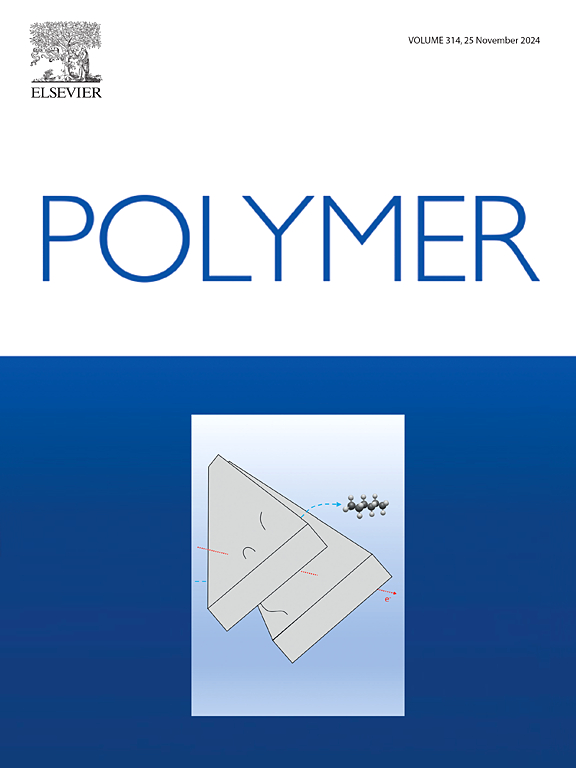重新评估聚乳酸在聚乙烯基底上的外延机制
IF 4.1
2区 化学
Q2 POLYMER SCIENCE
引用次数: 0
摘要
聚l -乳酸(PLLA)在具有折叠链层状结构的取向聚乙烯(PE)薄膜上外延结晶,得到了沿PE链方向排列的多数PLLA片层和向PE链方向倾斜64°的少数PLLA片层的交叉斜切边片层结构。主要PLLA片的起源与软外延有关,也称为石墨外延,基于PLLA链沿着由PE晶体和非晶态区域交替排列的凹槽排列。本研究采用原子力显微镜和透射电镜结合电子衍射技术,制备了具有纤维结构的定向PE薄膜,并对其上PLLA的结晶进行了详细的研究。发现PLLA也可以在这些PE薄膜上外延生长,外延结晶的结果基本上是相同的片层结构。这显然与之前关于软外延的解释相悖,因为带有原纤维晶体的PE薄膜中的凹槽是沿着其分子链方向的。因此,基于PE的(hk0)晶格面与PLLA的(00l)晶格面之间的良好匹配,特别是PE的(110)和PLLA的(007)晶格面之间的差异仅为0.3%,这与异质外延相关。虽然PE的d(100)与PLLA的d(004)之间的不匹配(约2.5%)看起来有些差,但从分子拓扑的角度来看,实现外延实际上是更可行的。本文章由计算机程序翻译,如有差异,请以英文原文为准。


Reassessment of the epitaxial mechanism of Poly(l-lactic acid) on polyethylene substrate
Epitaxial crystallization of poly (l-lactic acid) (PLLA) on oriented polyethylene (PE) films with fold chain lamellar structure has been confirmed to produce cross-hatched edge-on lamellar structure with majority of PLLA lamellae aligned along the PE chain direction while minor PLLA lamellae inclined by 64° to the PE chain direction. The origin of the major PLLA lamellae has been correlated to a soft epitaxy, also referred to as graphoepitaxy, based on the alignment of PLLA chains along the grooves made of alternatively arranged PE crystalline and amorphous regions. Here in this study, oriented PE films with fibril structure have been prepared and crystallization of PLLA on them has been studied in detail by atomic force microscopy and transmission electron microscopy combined with electron diffraction. It has been found that PLLA can also grow epitaxially on these PE films, and the epitaxial crystallization results in essentially the same lamellar structure. This is clearly against the previous explanation of soft epitaxy, since grooves in PE film with fibril crystals are along its molecular chain direction. It has, therefore, been correlated to the heteroepitaxy based on an excellent matching between (hk0) lattice planes of PE and (00l) lattice planes of PLLA, especially the one between (110) and (007) lattice planes of PE and PLLA with a discrepancy of only 0.3 %. Although the mismatching between d(100) of PE and d(004) of PLLA, ca. 2.5 %, looks somewhat inferior, it is actually more feasible to realize the epitaxy from the view of molecular topology.
求助全文
通过发布文献求助,成功后即可免费获取论文全文。
去求助
来源期刊

Polymer
化学-高分子科学
CiteScore
7.90
自引率
8.70%
发文量
959
审稿时长
32 days
期刊介绍:
Polymer is an interdisciplinary journal dedicated to publishing innovative and significant advances in Polymer Physics, Chemistry and Technology. We welcome submissions on polymer hybrids, nanocomposites, characterisation and self-assembly. Polymer also publishes work on the technological application of polymers in energy and optoelectronics.
The main scope is covered but not limited to the following core areas:
Polymer Materials
Nanocomposites and hybrid nanomaterials
Polymer blends, films, fibres, networks and porous materials
Physical Characterization
Characterisation, modelling and simulation* of molecular and materials properties in bulk, solution, and thin films
Polymer Engineering
Advanced multiscale processing methods
Polymer Synthesis, Modification and Self-assembly
Including designer polymer architectures, mechanisms and kinetics, and supramolecular polymerization
Technological Applications
Polymers for energy generation and storage
Polymer membranes for separation technology
Polymers for opto- and microelectronics.
 求助内容:
求助内容: 应助结果提醒方式:
应助结果提醒方式:


